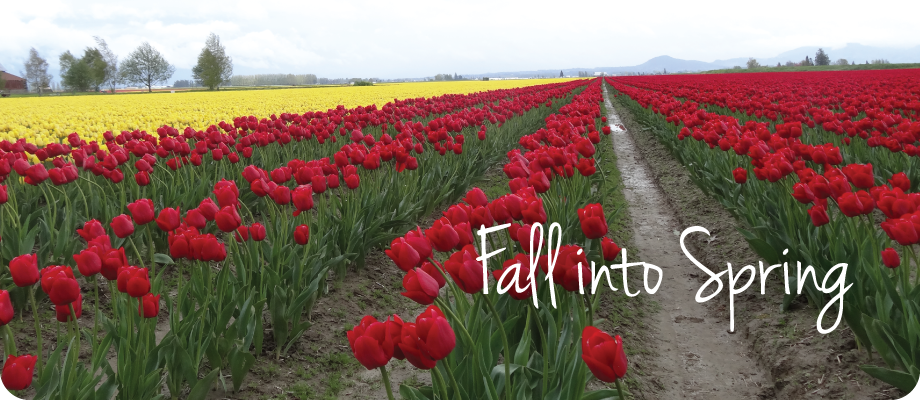
by Susan | Oct 17, 2014 | garden travel, gardening, plants
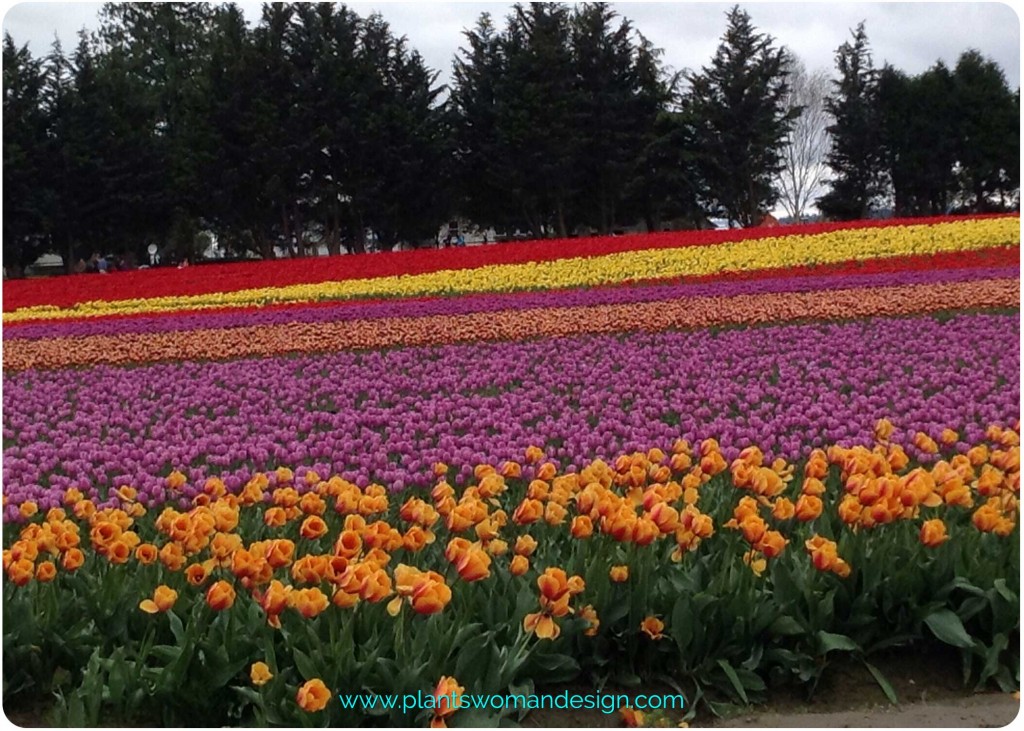 Remember the blog post from this past spring when I visited the tulip fields in Mt Vernon? They had the most spectacular display gardens, I took lots of pictures, you can read about it HERE. Now is the time to order. September through December you can pick bulbs from the list at www.tulips.com and they will send them off to you. I was not ready to pre-order last spring because I didn’t know where I was going to be. Now I’m ready and I’m going back through the pictures I took to get the labels. If I find a tulip I like I take a picture of the tulip up close and then a picture of the label. I try to always keep them in order so I can see which goes with that but it isn’t hard to figure out if you get mixed up. They have lots to choose from. Remember deer love tulips so if you have lots of 4 hoofed friends choose either daffodils (narcissus) or Allium bulbs. They are not on the favorite food list.
Remember the blog post from this past spring when I visited the tulip fields in Mt Vernon? They had the most spectacular display gardens, I took lots of pictures, you can read about it HERE. Now is the time to order. September through December you can pick bulbs from the list at www.tulips.com and they will send them off to you. I was not ready to pre-order last spring because I didn’t know where I was going to be. Now I’m ready and I’m going back through the pictures I took to get the labels. If I find a tulip I like I take a picture of the tulip up close and then a picture of the label. I try to always keep them in order so I can see which goes with that but it isn’t hard to figure out if you get mixed up. They have lots to choose from. Remember deer love tulips so if you have lots of 4 hoofed friends choose either daffodils (narcissus) or Allium bulbs. They are not on the favorite food list.
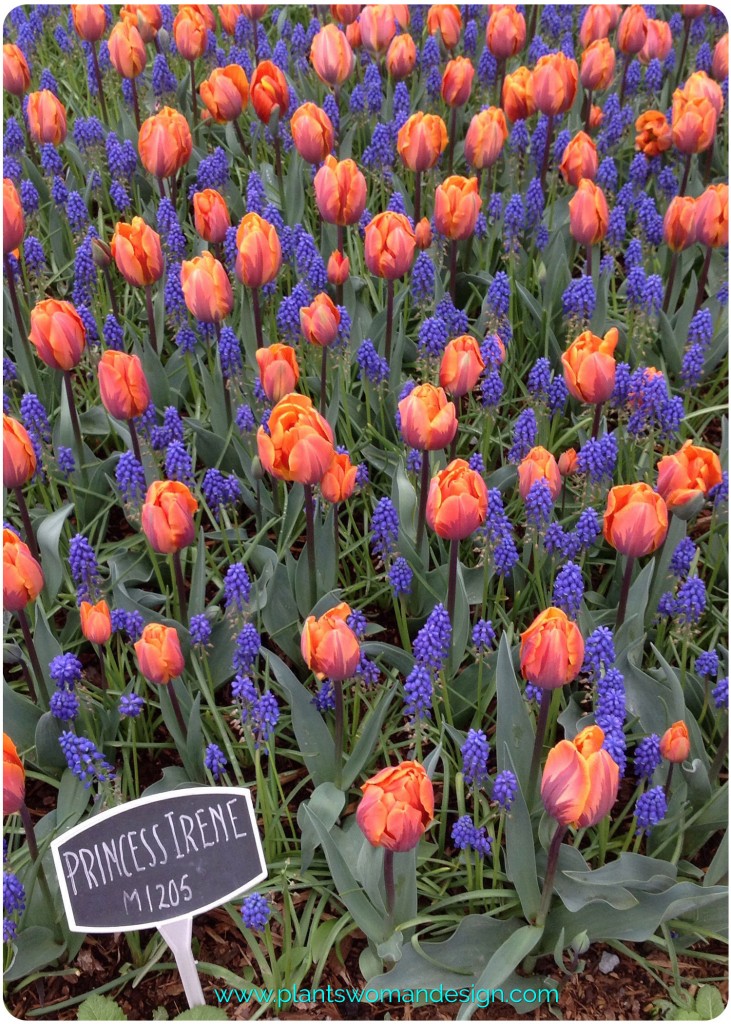
I discovered the difference in these bulbs last year. For the garden show I got quite a few bulbs online from another company and got a 20% successful force rate. That is horrible. Another designer had forced bulbs from Roozengarde and they were absolutely stunning. OK…. Buy Local!!
Are you planning on planting bulbs? What varieties have tickled your fancy this year?
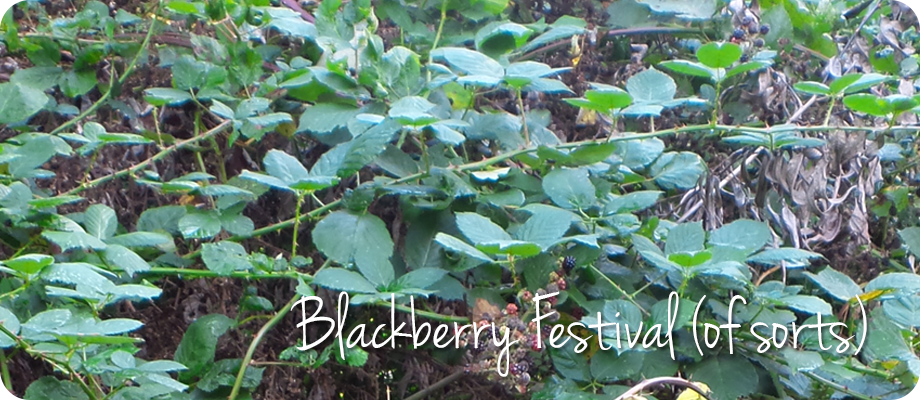
by Susan | Oct 15, 2014 | gardening, Plantswoman Design
Really, there is a blackberry festival in Bremerton, Washington. They celebrate blackberries. Fun runs, children’s events, and food and wine made with blackberries. I kind of get it but the Himalayan blackberry is a terribly invasive weed. Much like kudzu in the south, blackberries are attempting to cover the world. They spread by seed, root where they touch the ground and send underground runners. Himalayan blackberry was brought to the PNW by Luther Burbank in 1885. This plant was lauded and sold in nurseries. The plant spread outside the garden and has been a problem ever since. The city of Seattle alone is attempting to eradicate the blackberry from 2500 acres of parkland. They estimate that 20 percent of parkland are covered by the invasive weed and estimate that it will cost $ 25,000.00 per acre to remove it.
Keeping with the spirit of things I had my own blackberry festival this weekend. About 30% of my property is covered with this weed and I have battled them since I moved in. Cutting them down with a bladed weed trimmer, spraying the regrowth with brush killer then finally digging out the node that is just below the ground. Here is a picture of the stems of a plant that I cut down. The vines were climbing up a tree and were well over 30 feet high. Now that’s a weed! What is even more disturbing is that after an area was cleared of blackberry I found Bindweed and yellow archangel growing in the cleared off soil. Both of these are on the noxious weed list too!
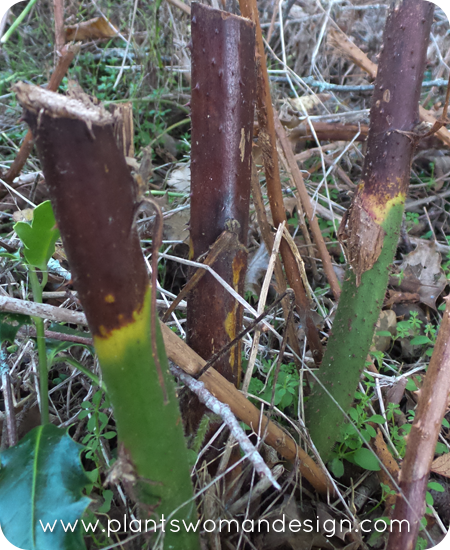
All three of these noxious weeds are considered class C noxious weeds by the Washington State Noxious Weed Board. This means individual counties can determine the control measures within the county. Class A noxious weeds are controlled by law. When you get around to it the topic of noxious weeds is very interesting reading. Many gardens in Washington have several of these weeds in their garden beds. Several years ago I found Milk Thistle on a garden center bench for sale and wanted to pitch it. It is good to be aware of what is out there, what you might have in your garden, and what you can do to control weeds in your area. The website has good suggestions for how to eradicate and what the weeds look like. Get out there and start weeding!
Check out this link http://www.nwcb.wa.gov
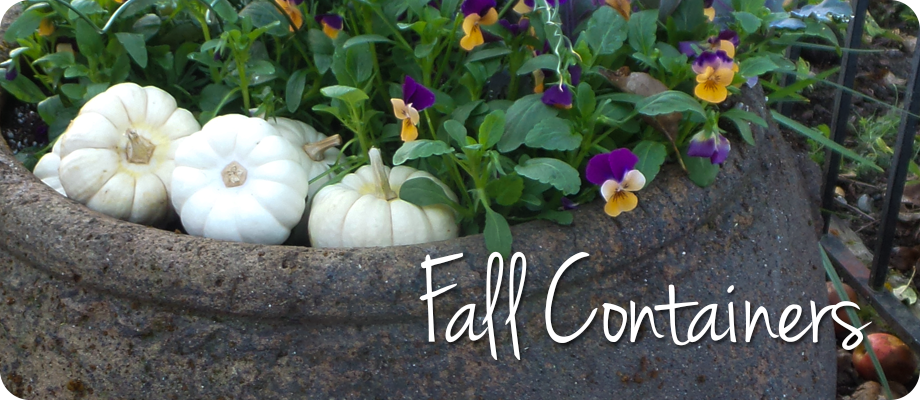
by Susan | Oct 8, 2014 | gardening
My containers are looking pretty bad.
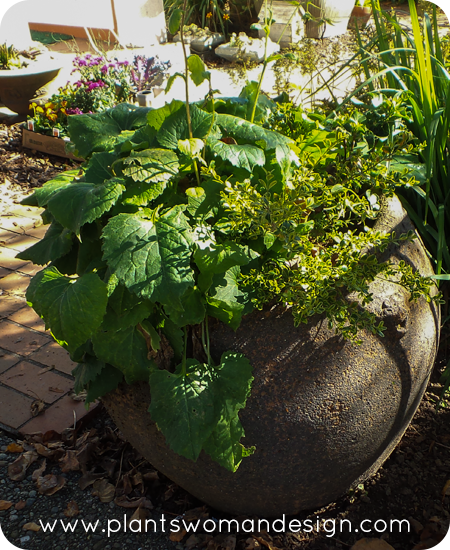
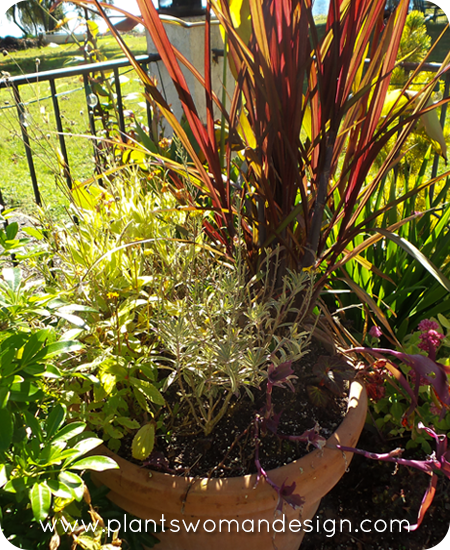 The other container that I did in the spring blog looks good still, just dull and is not blooming.
The other container that I did in the spring blog looks good still, just dull and is not blooming.
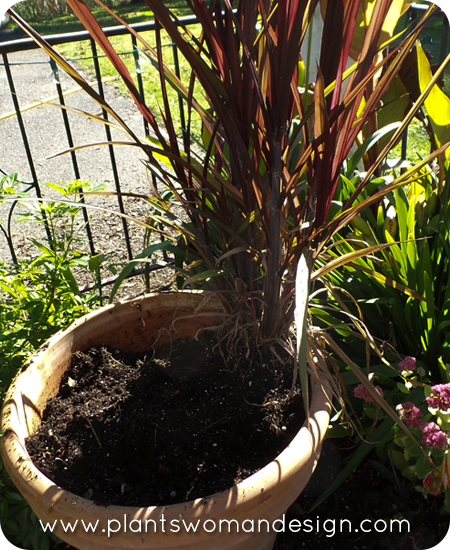
So, it’s time to replant the terra cotta pot. I took all the plants except the large pennisetum grass out of the terra cotta container; it will be good for height in this planting combination. I went to the nursery and grabbed some violas, White and purple cabbage and purple mums. There is also a really cool corkscrew rush that I will use as a center for the rustic container.
I use the same design principals in the containers as I do in the landscape. Since both of the containers are in the same general area and can been seen from each other I will use some of the same elements in both containers in different combinations. Repetition of plant material will help the design look cohesive.
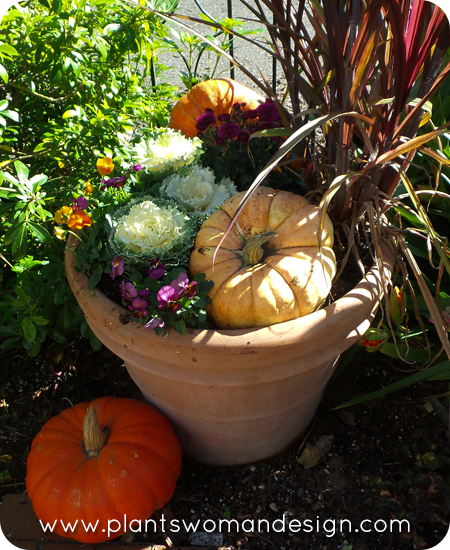
In the terracotta container I put in pennisetum purpureum vertigo, white and green cabbage, Penny Orange Viola, Orange sorbet viola, Purple Mum. For accent added Cinderella Pumpkins, and a ‘pink’ pumpkin which was more orange than pink.
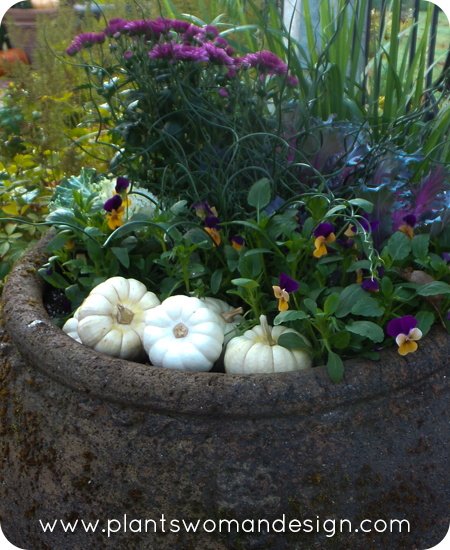
In the rustic container, Juncus –Corkscrew rush, Regal Cheryl purple mum, White Cabbage, Purple Cabbage, plum antique viola and white mini pumpkins.
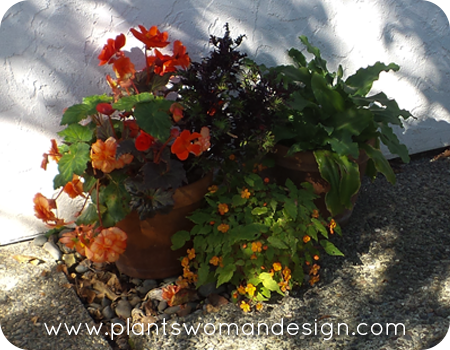
These two containers are close to the other two. They were planted in the summer and the combination of the orange begonias and the purple-fingered coleus go with the purples and orange in the new containers. They will continue to put out blooms and color until first frost.
by Susan | Sep 5, 2014 | gardening
With my move to the new house I left my beloved veg garden behind. After the dust settled I wasted no time putting in a new raised bed garden at the new place on the 4th of July (you can read about it HERE). This is what it looked like after I planted it.
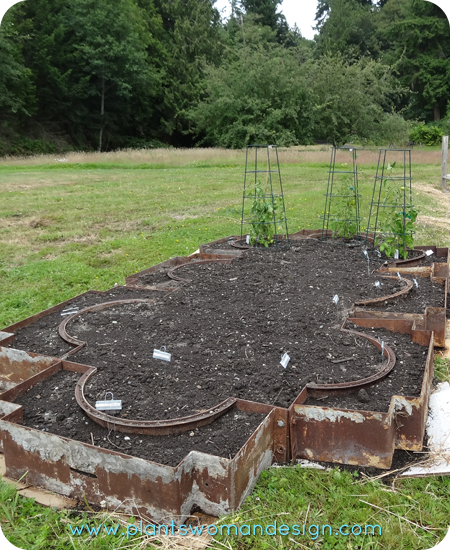 Here’s what it looks like now…
Here’s what it looks like now…
 Such an amazing difference a month and a half makes! Thanks especially to the plentiful sunshine we’ve had this summer. Here is a close up look…
Such an amazing difference a month and a half makes! Thanks especially to the plentiful sunshine we’ve had this summer. Here is a close up look…
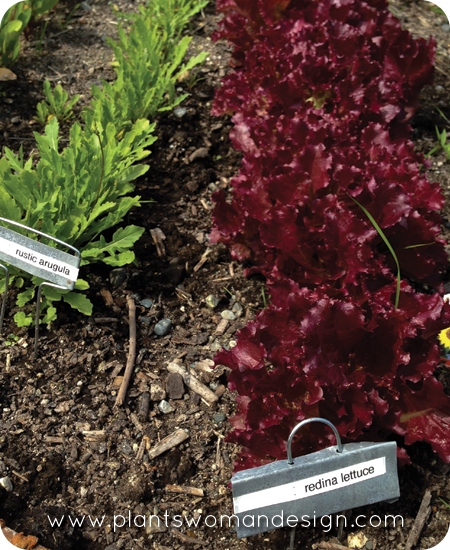
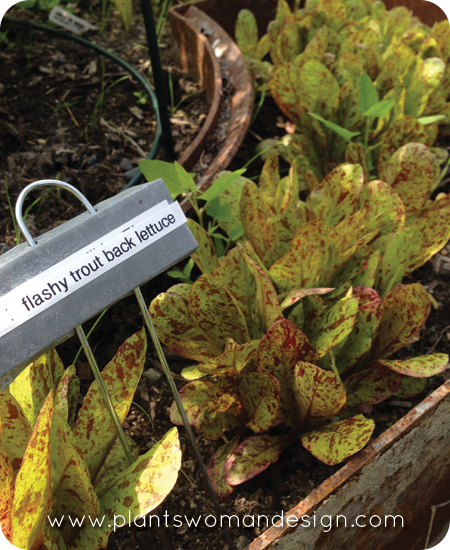
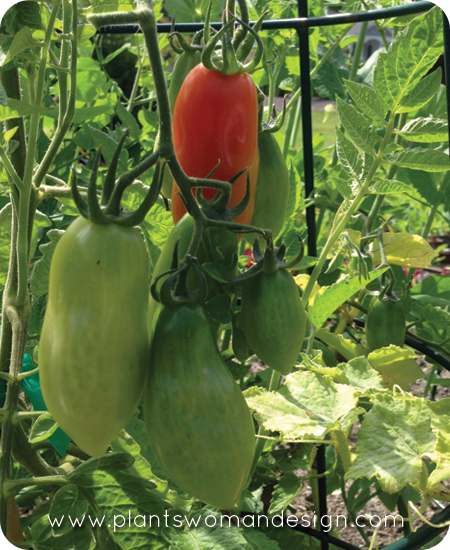
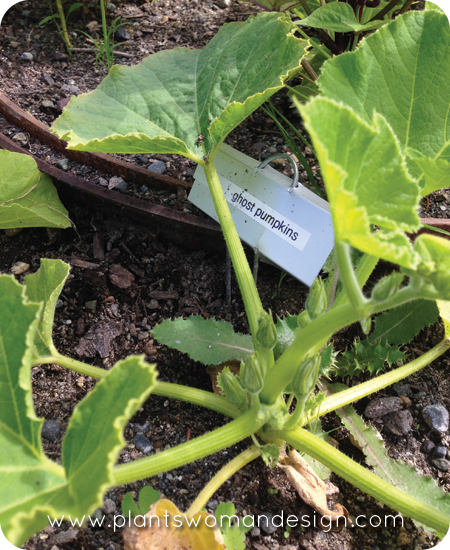 Not pictured is the collection of herbs tucked in here and there through out the beds. As you can see the garden is not heading autumn’s call to go to bed yet. Keep watering and keep harvesting!
Not pictured is the collection of herbs tucked in here and there through out the beds. As you can see the garden is not heading autumn’s call to go to bed yet. Keep watering and keep harvesting!
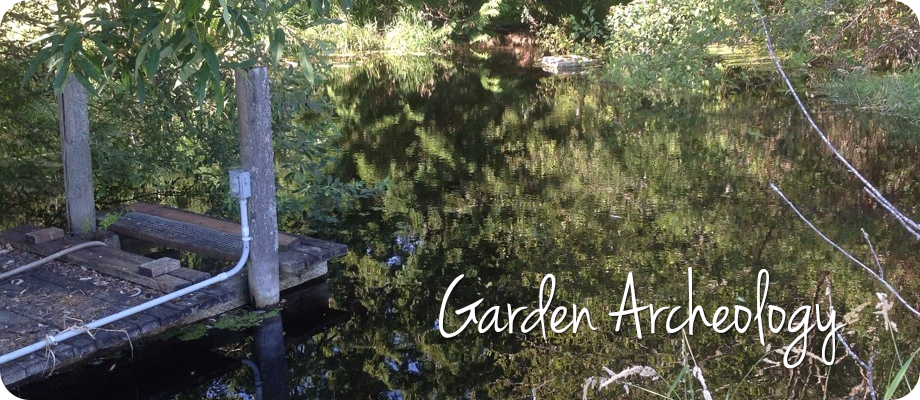
by Susan | Jul 18, 2014 | gardening
“Landscape archaeology is the study of the ways in which people in the past constructed and used the environment around them. Landscape archaeology is inherently multidisciplinary in its approach to the study of culture, and is used by both pre-historical, classic, and historic archaeologists. The key feature that distinguishes landscape archaeology from other archaeological approaches to sites is that there is an explicit emphasis on the study of the relationships between material culture, human alteration of land/cultural modifications to landscape, and the natural environment. The study of landscape archaeology (also sometimes referred to as the archaeology of the cultural landscape) has evolved to include how landscapes were used to create and reinforce social inequality and to announce one’s social status to the community at large.”
Above is the definition of Garden archeology or Landscape archaeology as defined by Wikipedia. I find it interesting that the evolution of this type of archeology includes how the garden/landscape was about social status. Growing up I always thought of people with gardens as poor. They had to grow their own food, not just go buy it. Somehow, in my mind, it was because they didn’t have the money, not that they would do it because they could. My Mom experienced this growing up. Their meals consisted of what her dad could catch, or they could catch as children. She grew to dislike clams, mussels and fish because that was all they ever got to eat. We (as kids) grew up eating meat, never fish or shellfish because of my mom’s view of what was acceptable and her idea of success. Now I view fish and shellfish as amazing and expensive and home grown produce as the freshest and best way to eat. Funny how the pendulum swings…
Now I know as I start to talk about the garden here at Beach Ave we aren’t talking true ‘archeology’. But this simple garden does have history and the evidence of its past can either be embraced or discarded at my whim. There is no definite historical significance to the garden here but there is a history of a place that was cultivated, planned, and enjoyed. Knowing that someone planned the ponds, put fish in them for grand-kids to fish for and places to swim adds a close emotional element as I plan their restoration.
I regret that I didn’t really try to understand or explore my last garden. The original owner (not the ones I bought from) had built a gazebo with Chinese characters around the walls, a concrete pond with waterfall, and an old oriental cart as decoration left out in the garden. Now I wish I would have found something out about the history. Those things are still there but their history is unknown. Is it important? It is not? What do you think?
Here are some pictures of existing ponds and elements in their current state at the beach garden. I am excited to see and share the changes and growth of a new garden on old soil.
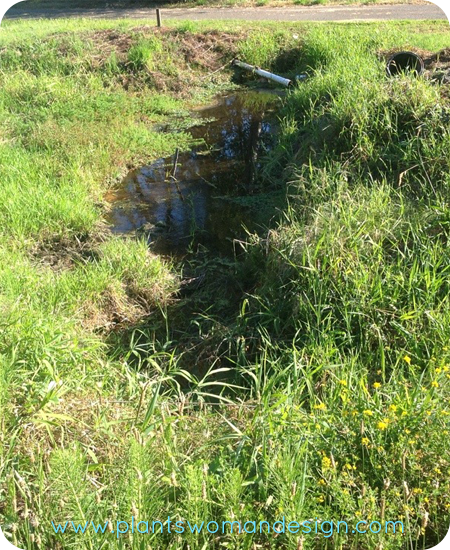
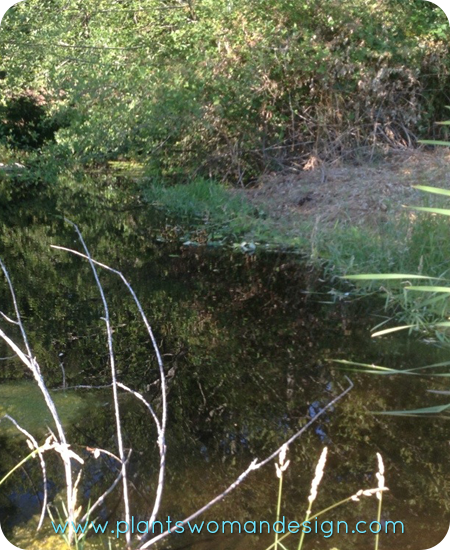
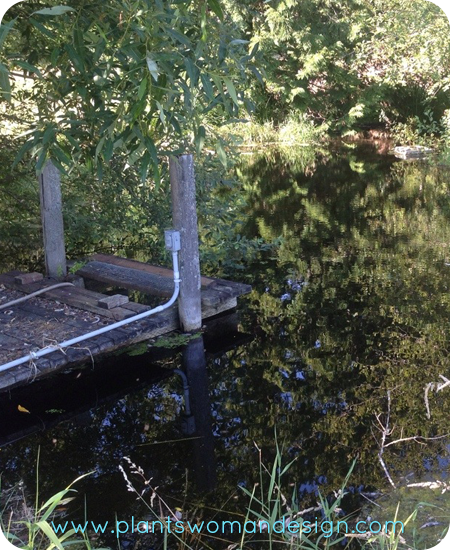
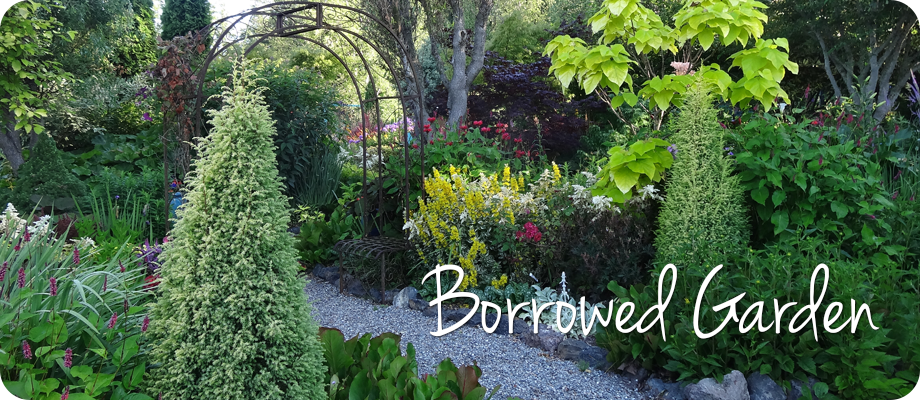
by Susan | Jul 16, 2014 | gardening, Plantswoman Design
Working in my once neglected garden I feel a little like a garden archeologist. Yes there really is such a thing. The garden I have now was once someone’s favorite project. The man who used to live here 15 years ago spent time creating this garden. He dug 3 ponds, had an elevated water aqueduct that spilled into a concrete waterwheel. An arching bridge past by it so the observer could enjoy the water wheel. It had two docks with a fountain in one of the ponds. I heard from my neighbor Jeanne that the gardener had died just 3 weeks after she moved in. In the following years the garden was left on its own. The ponds filled with algae, the stream beads were choked with weeds and alders, the aqueduct collapsed and wheel stopped turning. By then, Jeannie was engaged in her own project of remodel and garden. In the years to follow the garden she created grew and flourished, while the garden next door fell back into uncultivated earth again.
Have you ever wanted to borrow a garden? Kinda like borrowing a fancy dress for a party. You love it even though it’s not really yours but want to have the look for an evening. As I look over the acres of grass that is my ‘garden’ that is how I feel about Jeannie’s garden.
Jeannie’s garden is amazing. She has created a traditional cottage style garden with good bones. The garden by the house is lovely with aspen, hydrangeas and fruits with a small dock over the water. When they bought the small lot across the drive she created another stunning garden. Structure and texture are evident in all the beds with evergreen shrubs, arbors, garden house, and trellises. Pathways are gravel and mulch with care taken to maintain the edges.
She has beautiful plant combinations and has created an amazing garden of colors and textures with quiet (and not so quiet) places to sit and rest.
I drive by this lovely place every day, I mow next to it and have been invited to stroll its paths. I enjoy seeing her unusual plants, blooming things, and passionate use of color. She’s in her garden at 6 am and again at 8pm (her husband retired recently and she told him he could sleep until 7:30 then she wanted his help in the garden). She came over the other day and said, “Let me see what you have done.” Funny I didn’t think it was much but she immediately said it already looks like a garden. Indeed it does. I am so lucky to be next to a kindred spirit. We will watch together as it grows and changes. I’m sure we will share plants, ideas and failures.
Until next time grow on.

by Kristen | May 30, 2014 | gardening
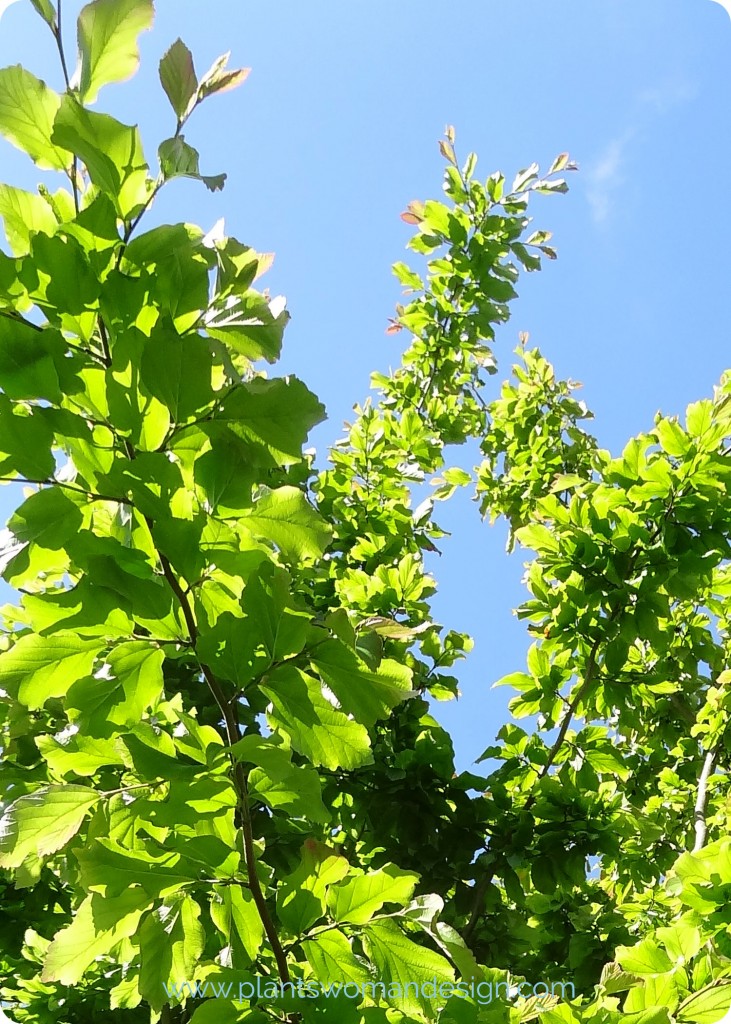 This time of year folks want to get out into their gardens and do work. Rightly so! But here’s the deal, as Susan would say, don’t go out and “weed” with your pruners. There are very few things in your yard right now that would take kindly to pruning. While we commend your “get out and do” spirit take a moment to review THIS article from the Arbor Day Foundation before taking your pruners out into the garden.
This time of year folks want to get out into their gardens and do work. Rightly so! But here’s the deal, as Susan would say, don’t go out and “weed” with your pruners. There are very few things in your yard right now that would take kindly to pruning. While we commend your “get out and do” spirit take a moment to review THIS article from the Arbor Day Foundation before taking your pruners out into the garden.
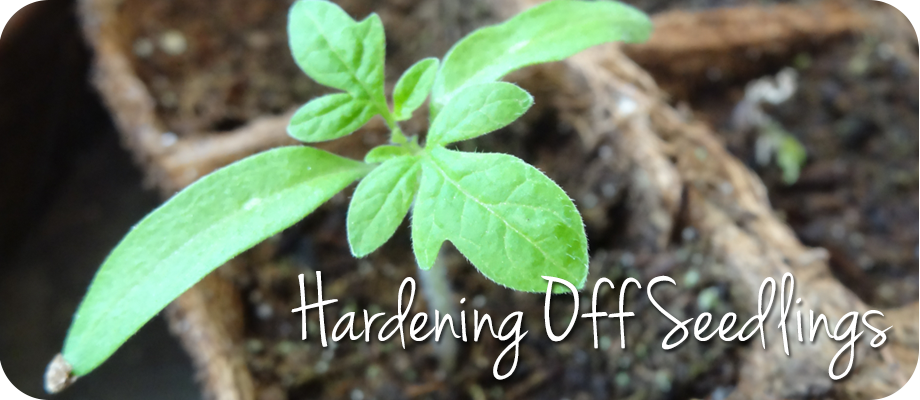
by Kristen | May 24, 2014 | gardening
 If you planted anything from seeds early this spring it’s time to start moving them outside to their permanent homes. Before you send those tender sprouts out into the garden take some time to harden them off. To learn more about the process of hardening off your seedlings take a look HERE and HERE or click below.
If you planted anything from seeds early this spring it’s time to start moving them outside to their permanent homes. Before you send those tender sprouts out into the garden take some time to harden them off. To learn more about the process of hardening off your seedlings take a look HERE and HERE or click below.
Growing Gardens: Hardening Off Plant Starts
Hardening Off Your Seedlings

by Kristen | May 23, 2014 | gardening
 Depending on your area it may be time to get out and prune your evergreen shrubs (please note we said shrubs not trees). Take a look at this article from the Royal Horticulture Society for some timely tips before you head out.
Depending on your area it may be time to get out and prune your evergreen shrubs (please note we said shrubs not trees). Take a look at this article from the Royal Horticulture Society for some timely tips before you head out.
Pruning Evergreen Shrubs

 Remember the blog post from this past spring when I visited the tulip fields in Mt Vernon? They had the most spectacular display gardens, I took lots of pictures, you can read about it HERE. Now is the time to order. September through December you can pick bulbs from the list at www.tulips.com and they will send them off to you. I was not ready to pre-order last spring because I didn’t know where I was going to be. Now I’m ready and I’m going back through the pictures I took to get the labels. If I find a tulip I like I take a picture of the tulip up close and then a picture of the label. I try to always keep them in order so I can see which goes with that but it isn’t hard to figure out if you get mixed up. They have lots to choose from. Remember deer love tulips so if you have lots of 4 hoofed friends choose either daffodils (narcissus) or Allium bulbs. They are not on the favorite food list.
Remember the blog post from this past spring when I visited the tulip fields in Mt Vernon? They had the most spectacular display gardens, I took lots of pictures, you can read about it HERE. Now is the time to order. September through December you can pick bulbs from the list at www.tulips.com and they will send them off to you. I was not ready to pre-order last spring because I didn’t know where I was going to be. Now I’m ready and I’m going back through the pictures I took to get the labels. If I find a tulip I like I take a picture of the tulip up close and then a picture of the label. I try to always keep them in order so I can see which goes with that but it isn’t hard to figure out if you get mixed up. They have lots to choose from. Remember deer love tulips so if you have lots of 4 hoofed friends choose either daffodils (narcissus) or Allium bulbs. They are not on the favorite food list.


























